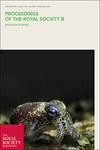当食草量大的时候,鼠尾草的报警叫声会聚集在一起。
IF 3.8
1区 生物学
Q1 BIOLOGY
Proceedings of the Royal Society B: Biological Sciences
Pub Date : 2024-09-18
DOI:10.1098/rspb.2024.1513
引用次数: 0
摘要
草食性几乎是所有植物的主要威胁,因此避免草食性的适应性通常会被选中。一种潜在的适应能力是 "倾听 "正在遭受食草动物侵害的植物发出的挥发性信号,然后通过加强防御来做出反应。人们对这些挥发性线索的性质知之甚少。如果发出信号的植物和接收信号的植物具有相似的挥发性排放特征,这种诱导效果最好。此前,我们观察到,与草食性较低的种群相比,草食性较高地区的鼠尾草种群表现出的挥发性物质多样性很少。有几种假设可能会产生这种相关性。高草食性风险可能会选择聚集在一个共同的 "警报线索 "上的个体,所有个体都会对该线索做出反应。在这种情况下,当食草动物大量出现时,窃听能力较弱的局部稀有化学型个体会比普通化学型个体遭受更多的伤害。另一种情况是,较低的化学型多样性可能会对植物造成较高程度的损害。在这种情况下,稀有的化学型比常见的化学型受到的伤害要小。我们研究了多个地点的鼠尾草个体的化学型,发现当食草动物大量繁殖时,稀有化学型比普通化学型受到的伤害更大。这种模式出现在不同地点和食草动物密度不同的年份。这一结果与食草动物选择有效沟通个体并塑造沟通系统的假设是一致的。本文章由计算机程序翻译,如有差异,请以英文原文为准。
Alarm calls of sagebrush converge when herbivory is high.
Herbivory is a major threat to virtually all plants, so adaptations to avoid herbivory will generally be selected. One potential adaptation is the ability to 'listen in' on the volatile cues emitted by plants that are experiencing herbivory and to then respond by ramping up defences. The nature of these volatile cues is poorly understood. Sagebrush (Artemisia tridentata) plants that were exposed to cues of experimentally damaged neighbours experienced less herbivory; this induction was most effective if emitter and receiver plants had similar volatile emission profiles, termed chemotypes. Previously, we observed that sagebrush populations that were in locations with high herbivory exhibited little diversity of volatiles compared to populations with low herbivory. Several hypotheses could produce this correlation. High risk of herbivory could have selected for individuals that converged on a common 'alarm cue' that all individuals would respond to. In this case, individuals of locally rare chemotypes that were less able to eavesdrop would experience more damage than common chemotypes when herbivores were abundant. Alternatively, low chemotypic diversity could allow higher levels of damage to plants. In this case, rare chemotypes would experience less damage than common chemotypes. We examined the chemotypes of sagebrush individuals from multiple sites and found that rare chemotypes experienced more damage than common chemotypes when herbivores were abundant. This pattern was seen among sites and among years with different densities of herbivores. This result is consistent with the hypothesis that herbivory selects for individuals that are effective communicators and shapes the communication system.
求助全文
通过发布文献求助,成功后即可免费获取论文全文。
去求助
来源期刊
CiteScore
7.90
自引率
4.30%
发文量
502
审稿时长
1 months
期刊介绍:
Proceedings B is the Royal Society’s flagship biological research journal, accepting original articles and reviews of outstanding scientific importance and broad general interest. The main criteria for acceptance are that a study is novel, and has general significance to biologists. Articles published cover a wide range of areas within the biological sciences, many have relevance to organisms and the environments in which they live. The scope includes, but is not limited to, ecology, evolution, behavior, health and disease epidemiology, neuroscience and cognition, behavioral genetics, development, biomechanics, paleontology, comparative biology, molecular ecology and evolution, and global change biology.

 求助内容:
求助内容: 应助结果提醒方式:
应助结果提醒方式:


